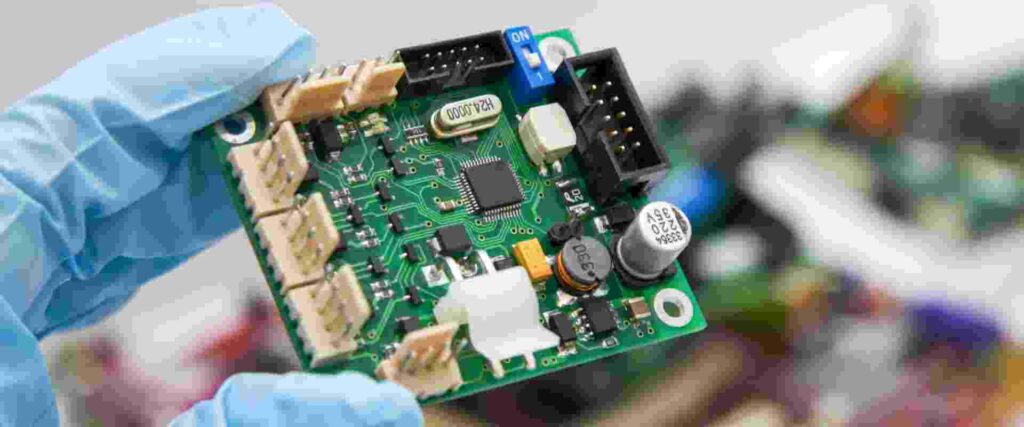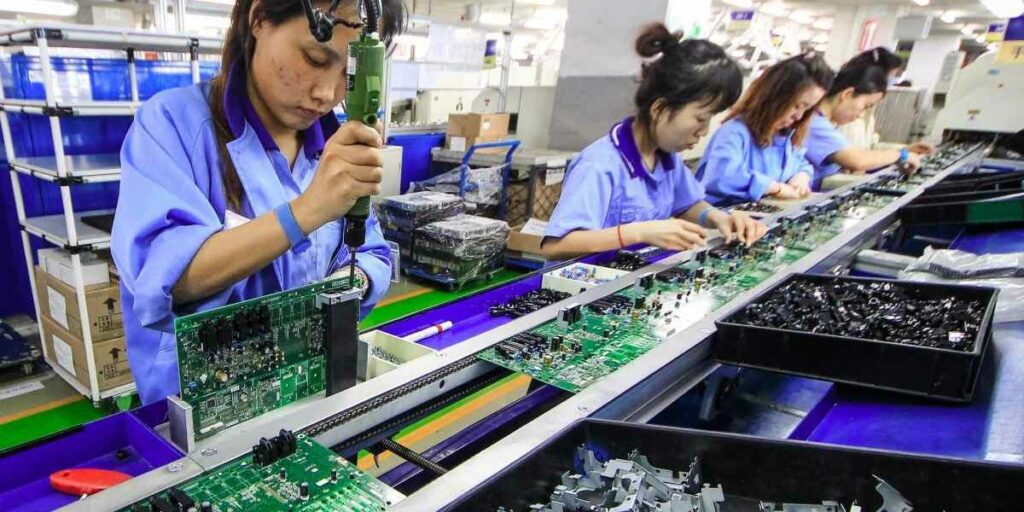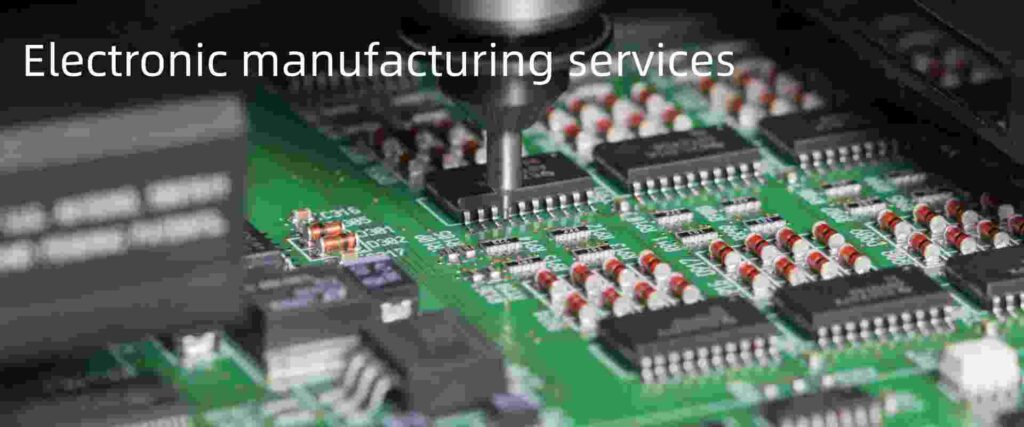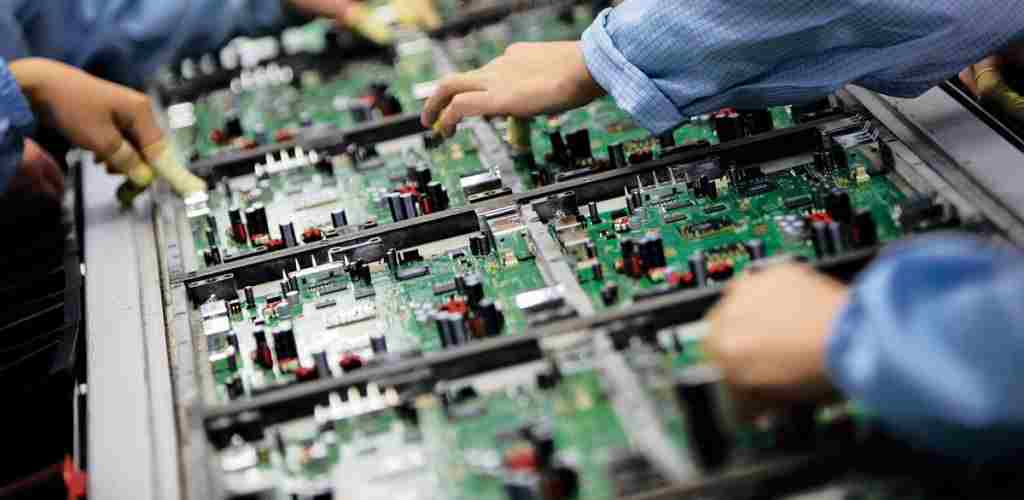Introduction
Electronic product manufacturing is the process of designing, assembling, testing and shipping completed electronic devices and components. It spans a wide range of products from consumer electronics to industrial equipment to automotive and aerospace electronics.
This article provides an in-depth overview of electronic product manufacturing including key steps in the process, technologies utilized, quality systems, contract manufacturing roles, costs and challenges.
Electronic Manufacturing Industry
The electronic manufacturing services (EMS) industry produces electronic products and assemblies for original equipment manufacturers (OEMs).
Major segments include:
- Consumer electronics like smartphones, wearables, home appliances
- Computers, servers, and networking equipment
- Telecommunications infrastructure and satellite communications
- Industrial, medical, transportation, and military electronics
- Semiconductors, sensors, and other components
The industry employs millions worldwide across fabrication, assembly, and test operations.
Electronic Product Manufacturing
Importance of Electronics Manufacturing
Electronic product manufacturing is important because:
- Enables innovation and commercially viable product development
- Allows cost-effective, high volume production
- Consistent quality according to specifications
- Leverages economies of scale in materials and labor
- Provides employment opportunities globally
- Foundational industry that powers technological progress
Reliable, efficient manufacturing brings new electronics products to diverse markets worldwide.
Key Steps in the Manufacturing Process

A typical sequence of steps to build an electronic product involves:
1. Design and Engineering
- Product requirements definition
- Circuit design and simulation
- PCB layout and modeling
- Mechanical engineering
- Regulatory approvals
- Prototyping and testing
2. Supply Chain Management
- Sourcing components, raw materials and subassemblies
- Vendor qualification and management
- Procurement, inventory control and logistics
3. PCB Fabrication and Assembly
- Fabricating bare PCBs
- Solder paste screening
- SMT pick and place assembly
- Reflow soldering
- Through-hole assembly
- Conformal coating
4. Product Assembly and Integration
- Incoming QC inspection
- Frame, chassis and enclosure assembly
- Subassembly installation (displays, motors)
- Final product assembly
- Labeling, etc.
5. System Testing
- In-circuit testing
- Functional testing
- Burn-in stress testing
- Environmental stress screening
- Quality audit
6. Shipment Preparation
- Programming/configuration
- Final packaging
- Warehousing
- Order fulfillment
Cross-functional teams help coordinate these complex manufacturing workflows.
Electronic Manufacturing Technologies

Modern electronics manufacturing leverages a variety of technologies and techniques:
Surface Mount Technology (SMT)
SMT attaches components directly to the PCB surface using solder pastes and reflow soldering, enabling miniaturization and automation.
SMT Assembly Line
Key SMT processes include:
- Solder paste screening
- Pick and place assembly
- Reflow soldering
- Automated optical inspection (AOI)
Together they enable high-speed printing, component placement, and soldering.
Through Hole Technology (THT)
THT involves inserting component leads through board holes and soldering them in place. Still used for connectors, transformers, and other components unsuited to SMT.
Through-Hole Assembly
Box Build Assembly
Installing and integrating components like displays, motors, batteries, speakers and other sub-systems into product enclosures and chassis.
Conformal Coating
Applying protective plastic films and sealants onto assembled PCBs to prevent environmental damage.
Conformal Coating Techniques
Programming and Configuration
Writing firmware, setting parameters, enabling features, and final product preparation and testing.
Modern electronics manufacturing leverages these processes for automated, high-quality production.
Quality Management Systems
Maintaining quality standards during manufacturing involves:
Incoming Inspection
Rigorously checking received materials and components according to acceptance criteria helps ensure defects aren’t introduced.
In-Process Quality Control
Monitoring key process performance metrics, equipment maintenance, and environment helps identify issues during manufacturing versus at finished product.
Traceability
Maintaining material and component traceability through unique identification and ERP helps isolate defects and improve accountability.
Process Control
Statistical methods and data analysis techniques help optimize processes by reducing variability and defects.
Corrective Action
Addressing quality deviations through containment, root cause analysis, and solving systemic issues.
Training and Certification
Skilled, certified operators following controlled instructions are key to minimizing human errors.
Electronics manufacturing quality directly impacts field reliability and customer satisfaction.
Custom Labels and Packaging

Distinctive labels, markings, and packaging help brands differentiate their products:
- Tamper-evident seals
- Instructional diagrams
- Regulatory markings
- Serial numbers and barcodes
- Cautionary warnings
- authenticity and security seals
- Attractive and informative packaging conveys quality
These finishing touches complete products prior to shipping.
Outsourcing and Contract Manufacturers
Many OEMs outsource production to contract manufacturers (CMs) that specialize in production:
Benefits of outsourcing include:
- Avoiding major capital investments
- Leveraging specialized expertise and capabilities
- Shifting production labor needs
- Focusing on core competencies like design
- Improving flexibility to demand fluctuations
- Time to market acceleration
Risks of outsourcing involve
- Loss of control and visibility
- Product security concerns
- Communication and coordination challenges
- Limited production innovation
- Overdependence on external partners
OEMs must weigh benefits against the risks when considering manufacturing strategies.
Geographical Considerations
Key factors regarding electronics manufacturing locations include:
Cost
- Labor costs, facility costs, tax incentives
- Lower costs attractive but can impede quality
Lead Times
- Proximity to markets speeds delivery times
- But long supply chains increase risk
Regulations
- Certification requirements
- Environmental regulations
- Export control restrictions
Supply Chain
- Established supply networks lower costs
- But concentrated risks like disasters, shipping
Talent
- Skilled workforce essential for quality
- Requires ongoing training and investment
Geography influences costs, agility, compliance, logistics, and innovation.
Electronic Manufacturing Costs
Major costs involved in electronics manufacturing include:
- Components and raw materials
- PCB fabrication expenses
- Assembly and integration labor
- Factory overhead
- Test equipment expenses
- Shipping and logistics costs
- Inventory carrying costs
- Manufacturing equipment investments
- Factory maintenance and safety
- Quality and engineering labor
- Management, facilities and IT overhead
High automation and volume help improve cost structures through economies of scale. Low cost labor markets also reduce costs but can impact quality.
Key Challenges in Electronics Manufacturing
Despite great progress, electronics manufacturing still faces challenges:
- Extreme miniaturization and component density complicates assembly and inspection
- Mixing through-hole and surface mount technologies on single boards adds complexity
- Shorter product life cycles necessitates rapid ramp up and changeovers
- High reliability demands for automotive, medical, and long-life products
- Difficulty securing control over deep multi-tier supply chains
- Scarcity of rare earth metals and other essential raw materials
- Trade policy uncertainty hampers long term planning and investment
- Geopolitical instability in some low cost manufacturing markets
- Cybersecurity threats against proprietary manufacturing data
Proactive risk management across the product lifecycle is key to addressing these complex issues.
The Future of Electronics Manufacturing
Advances on the horizon for manufacturing include:
- Expanding use of automation including robotics and AI for production
- Transitioning to data-driven smart factory environments with IoT integration
- Adoption of augmented reality to assist human workers
- Wider implementation of additive manufacturing for rapid prototyping
- Supply chain digitization and track-and-trace blockchains
- Self-healing manufacturing environments using ML algorithms
- Sustainable manufacturing reducing waste and energy use
Innovation in manufacturing will enable increased product customization, flexibility and resilience.
Conclusion
In summary, reliable, efficient electronic product manufacturing combines engineering, supply chain management, assembly, test, programming, and logistics to transform raw materials into finished goods. As volumes grow and products become more advanced, manufacturing innovations will be critical to delivering better performing, higher quality, and more affordable electronics products worldwide.
Electronic Product Manufacturing Frequently Asked Questions
Question 1: What are the main differences between consumer electronics and industrial electronics manufacturing?
Consumer electronics focuses on high volume, lower cost manufacturing often outsourced to contract manufacturers, while industrial electronics requires higher reliabilities with tighter process controls, traceability and special testing.
Question 2: What key factors should be considered when choosing an electronics contract manufacturer?
Important factors include technical capabilities, quality systems, manufacturing capacity, geographic location, culture, costs, supply chain networks, and financial viability. Site visits and engineering review of capabilities is essential.
Question 3: How can electronics manufacturers balance low manufacturing costs and quality?
Careful oversight and controls, extensive factory training, statistical process monitoring, rigorous quality testing, equipment maintenance programs and cultural prioritization of quality over lowest cost help achieve balanced cost optimization and quality.
Question 4: What are some key differences between printed circuit board fabrication and circuit board assembly?
PCB fabrication involves the raw board manufacturing process steps like laminating, drilling, plating, etching, solder mask while circuit board assembly is placing and soldering components onto the fabricated boards. The two stages require very different factories, skills and equipment.
Question 5: How are electronic products tested and qualified to meet safety and functional requirements before sale?
Extensive testing protocols required by regulatory bodies and internal design validation induce stresses like temperature cycling, vibration, electrical margins, and long duration burn-in to verify products meet specifications and reliability metrics.





